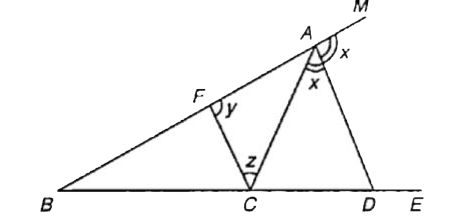In ΔABC if A=(0, 0, 4), AB=4, BC=3, CA=5, I=(1,0,1) is the incentre and the internal bisector of ∠A intersects BC at D then Dx= Solution in Telugu
43
−43
85
0
The correct Answer is:a
Step by step video, text & image solution for In DeltaABC if A=(0, 0, 4), AB=4, BC=3, CA=5, I=(1,0,1) is the incentre and the internal bisector of angleA intersects BC at D then D_(x )= by Maths experts to help you in doubts & scoring excellent marks in Class 11 exams.
Updated on:21/07/2023Topper's Solved these Questions
- 3D COORDINATE SYSTEMBook:AAKASH SERIESChapter:3D COORDINATE SYSTEMExercise:ADDITIONAL PRACTICE EXERCISE (LEVEL - II LECTRUE SHEET (ADVANCED)) (More than One correct answer Type Questions)
Explore 6 Videos
- 3D COORDINATE SYSTEMBook:AAKASH SERIESChapter:3D COORDINATE SYSTEMExercise:ADDITIONAL PRACTICE EXERCISE (LEVEL - II LECTRUE SHEET (ADVANCED)) (Matrix Matching Type Questions)
Explore 1 Video
- 3D COORDINATE SYSTEMBook:AAKASH SERIESChapter:3D COORDINATE SYSTEMExercise:PRACTICE SHEET (EXERCISE-I) (LEVEL-II) (Integer Type Questions)
Explore 1 Video
- 2D-COORDINATE SYSTEMBook:AAKASH SERIESChapter:2D-COORDINATE SYSTEMExercise:ADVANCED SUBJECTIVE TYPE QUESTIONS
Explore 14 Videos
- 3D-COORDINATE SYSTEMBook:AAKASH SERIESChapter:3D-COORDINATE SYSTEMExercise:PRACTICE EXERCISE
Explore 40 Videos
Similar Questions
P(1, 1, 1) and Q(1, 1, 1) are two points in the space such that PQ=√27, the value of l can be
View SolutionThe point to which the axes should be translated to eliminate first degree terms in the equation 2x2−2y2+z2−4x+8y−5=0 is
View SolutionIf the controid of the tetrahedron OABC where A,B,C are the points (a,2,3), (1,b,2) and (2,1,c) be (1,2,3) and the point (a,b,c) is at distance 5√λ from origin, then λ2 must be equal to.
View SolutionFind the area of equitateral triangle formed by (a,1), (1,b), (0,0) where o<a,b<1
View SolutionThe point (-1,4,-2) lie in the octant
View SolutionΔABC के लिए निम्नलिखित में से कोण-सा कथन सत्य नहीं है|
(i) −−→AB+−−→BC+−−→CA=0, (ii) −−→AB+−−→BC−−−→AC=0
(c ) −−→AB+−−→BC−−−→CA=0, (d) −−→AB−−−→CB+−−→CA=0
View SolutionΔABC में AB=6cm,BC=12cm और CA=6√3cm तब ∠A=
View SolutionThe bisector of ∠A of ΔABC intersects BC at D. IF BD:DC=4:7 and AC=3.5. Then AB=…………..
View SolutionIn ΔABC, the sides BC = 5, CA = 4, AB = 3. If A(0, 0) and the internal bisector of angle A meets BC in D(12/7,12/7) then incentre of ΔABC is
View SolutionIn ΔABC, if B = (1, 2), C = (5, 6) and the internal bisector of the angle at A cuts BC at D(4, 5) then AB:AC=
View SolutionThe bisector of the exterior ∠A of ΔABC intersects the side BC produced to D. Here CF is parallel to AD.

View SolutionThe bisector of ∠A of ΔABC cuts BC at D and the circumcircle of the triangle at E. then
View SolutionIn ΔABC, AC>AB and bisector of ∠A meets BC and D then ∠ADB is :
View SolutionIn ΔABC,AB=52,BC=56,CA=60. Let D be the foot of altitude from A, and E be the line intersection of the internal angle bisector of ∠BAC with BC. Then DE is
View SolutionIf in a ΔABC, BC =5, CA=4, AB=3 and D, E are the point on BC such that BD=DE=EC, then 8tan (∠CAE) must be
View Solution

